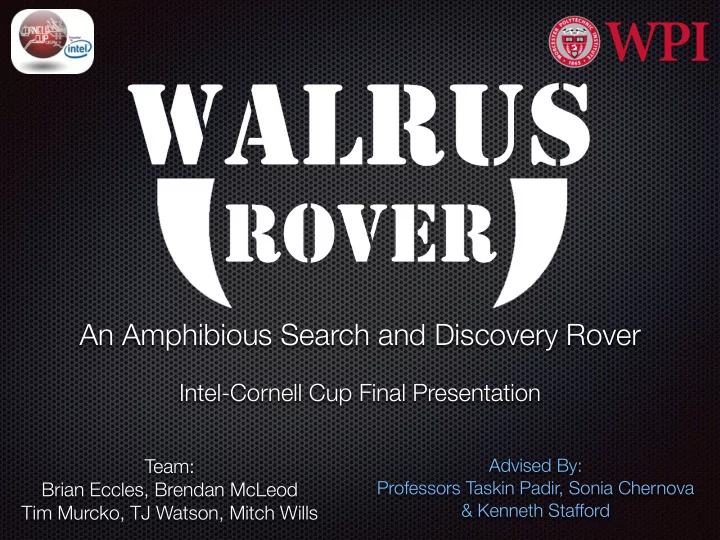

An Amphibious Search and Discovery Rover Intel-Cornell Cup Final Presentation Advised By: Team: Professors Taskin Padir, Sonia Chernova Brian Eccles, Brendan McLeod & Kenneth Stafford Tim Murcko, TJ Watson, Mitch Wills
2 Presentation Outline 1. Project Introduction • Project Motivation • Mission • The WALRUS Rover • Design Overview 2. Evaluation 3. Logistics
3 Project Motivation • Robots have been used in search and humanitarian missions since September 11th, 2001. • Current robots are… • Limited by deep water. • Targeted solutions. • High cost. • Closed systems with narrow expandability.
4 Mission To create a highly configurable amphibious rover for search and humanitarian missions at a competitive cost.
5 The WALRUS Rover • “Water and Land Remote Unmanned Search Rover” • Provide a mobile platform that… • Can overcome difficult terrain and bodies of water • Offers expansion through payload interfaces • Easily deployed & reconfigured in the field • Low cost solution
6 Design Overview Wireless Module Right Drive Controller Main Computer DC-DC Converter Power Failover 9” Diagnostics Display & Control Left Drive Controller 20” 25” Main Proprioception Board Main Contactor Left Drive Motor Front Flipper Motor & Gearing Rear Camera Front Camera Front Flipper Controller Front Flipper Controller Rear Flipper Motor & Gearing Right Drive Motor SMBus Isolation Board
7 Presentation Outline 1. Project Introduction 2. Evaluation • System Specification • Mobility • Power & Communications • Supervised Autonomy • User Interface • Payload Specifications • Future Improvements 3. Logistics
8 System Specifications Specification Requirement Actual Evaluation Maximum Land Speed: ≥ 6.5 ft/s 7 ft/s ✔ Maximum Water Speed: ≥ 1.69 ft/s 1 ft/s ✖ Static Stability Limit: ≥ 45° pitch, 30° 80° pitch, ≥ 65° ✔ roll roll Stair Capability: ≥ 37° 37° metal & ✔ rounded Total Weight: 80 lbs 82 lbs ✖ Stow Size: 32 in 20 x 25 x 9 in ✔ Typical Battery Life: 1.5 hours 3 hours ✔ Control Distance: 975 ft LoS 1200 ft ✔ Payload Capability: ≥ 10 lbs 10 lbs ✔ Water Payload Capability: ≥ 1 lb 1 lb ✔
9 Mobility • Land • Max speed: 7 ft/s • Tested terrains: • Tight pile carpet • Symmetric stepfield • 35° stairs • Crossing ramps • Pavement • Grass and mud • Water • Max speed: 1 ft/s • 20-30 minute safe runtime
10 Power & Communications • Power consumption: • Communications • ~3 hour runtime (two • Maintains video stream and batteries) control over 1000 ft • Charge state reported by BMS
11 User Interface
12 Supervised Autonomy • Autonomous stair climbing • Region growing based plane extraction • RANSAC model parameter estimation
13 Payload Communication • Internal IPC2 Intel Core i7: DE2i-150 FPGA Dev Kit • USB 3.0 • Gigabit Ethernet • HDMI Heat Fins • DE2i-150 FPGA Dev Kit: Payload Ethernet (1), • USB 2.0, RS-232 & TTL Serial USB 3.0 (1) & HDMI (1) • Gigabit Ethernet Payload Ethernet (2) & USB 3.0 (1) • Two-Way Audio Payload Power Payload Power (5V, 36V) • GPIO (5V, 12V, 24V) Diagnostics Display • HDMI & VGA & Control • Power Options: Payload USB 3.0 (1) & Wi-Fi Antenna • 5V, 12V, 24V & Unregulated 32V E-Stop 2” #10-32 Grid Plate
14 Future Improvements • Remove weight • Cost: 3 Months, $3,000 • Gain: Lower power required, water speed increase • Add cowlings to treads • Cost: 1 week, $50 • Gain: Water speed increase • Dynamic tread tensioner • Cost: 2 weeks, $200 • Gain: Better traversal over gravel
15 Presentation Outline 1. Project Introduction 2. Evaluation 3. Logistics • Gantt Chart • Outreach • Rover Costs • Sponsors
16 Gantt Chart
17 Outreach Turkish Military General Delegation Cambridge Science Festival Worcester Art Museum USAID’s Innovation on the Edge: Accelerating Solutions in the Fight Against Ebola V ECNA Robot Race
18 Rover Costs Chassis & Actuation Cost Electronics Cost Motors $2,750 Main Computer $1,000 Motor Controllers $2,000 Custom PCBs $2,000 Power Transmissions $3,430 Wiring and Connectors $1,500 Treads $2,800 Sensors $1,500 Raw Materials $1,500 Batteries and Chargers $4,400 Hardware $1,000 Misc. Electronics $1,600 Total $13,480 Total $12,000 Total Cost: $25,480
19 Sponsors
20 Questions? Email us: walrus@wpi.edu Visit us on the web: walrusrover.com Like us on Facebook: facebook.com/walrusrover
Recommend
More recommend